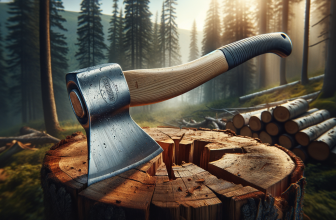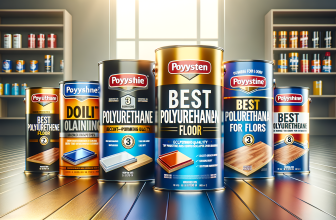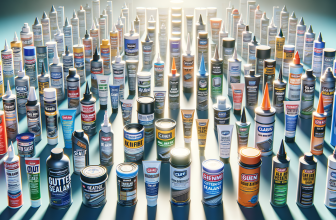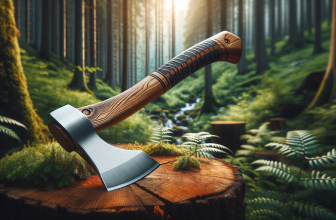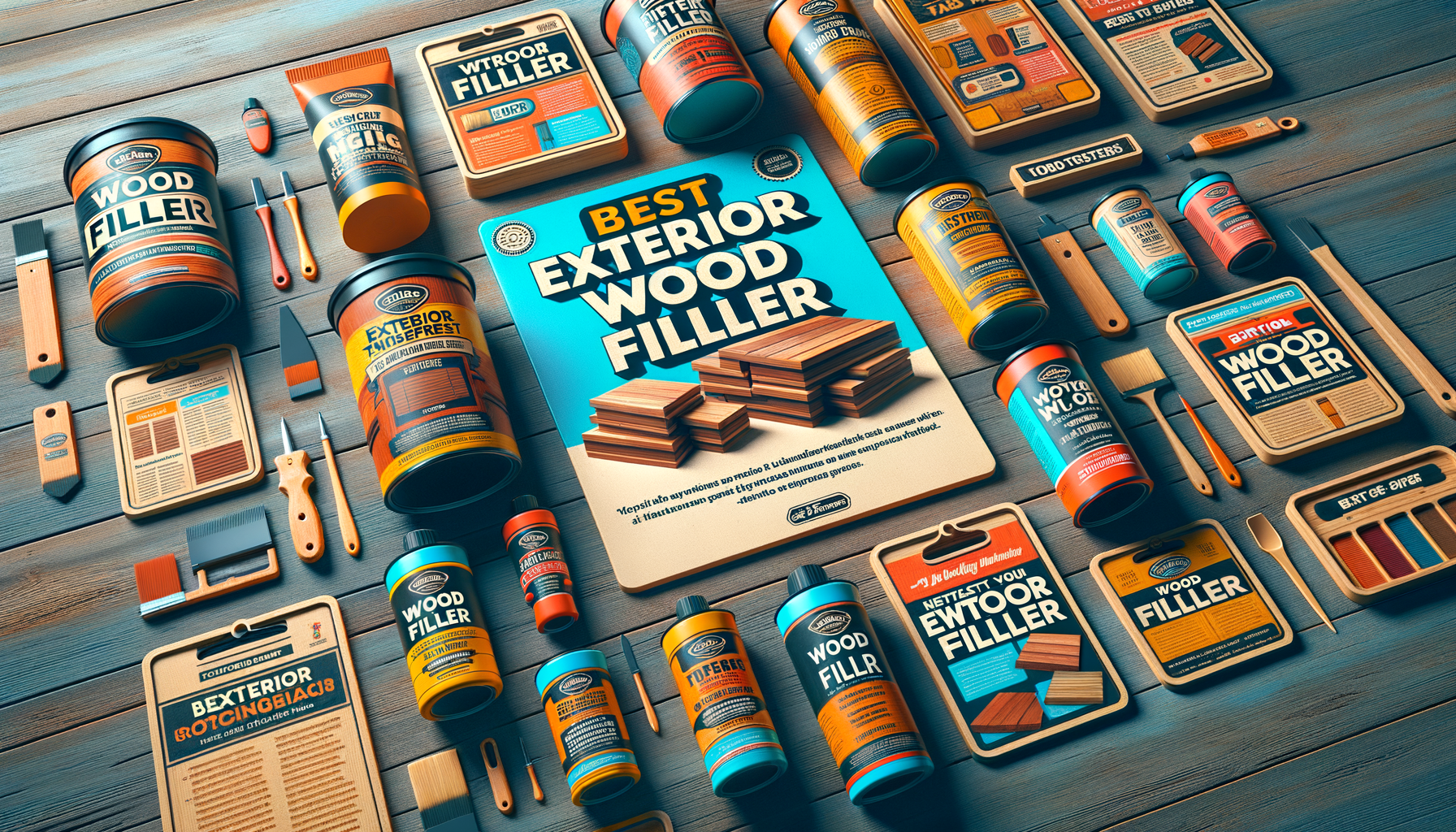
Are you on the lookout for the best exterior wood filler to tackle your latest home repair or woodworking project? Whether you’re filling unsightly nail holes, repairing weathered outdoor furnishings, or smoothing out uneven surfaces, finding the right wood filler can make all the difference in achieving a professional-grade finish that stands up to the elements.
Our Top Picks
Our #1 Top Pick: Minwax High Performance Wood Filler
Minwax is well-known in the woodworking community, and its High Performance Wood Filler lives up to the hype. This two-part wood filler is made of a blend of wood fibers, mineral fillers, and resin, which creates a compound that is exceptionally durable and sandable. Once it’s cured, it can be painted or stained like regular wood. It’s specifically designed for exterior use and can withstand all types of weather, making it an ideal choice for outdoor repairs.
Pick #2: Elmer’s E892 Stainable Wood Filler
For those looking to match their wood filler with the surrounding stain, Elmer’s E892 Stainable Wood Filler is a solid choice. This filler accepts stain beautifully, meaning you can seamlessly blend the repair with the existing wood. It’s also versatile enough to be used on both interior and exterior projects and has an easy to work with consistency that adheres well to wood.
Pick #3: Bondo Wood Filler
Bondo is a name synonymous with durable repairs, and their wood filler doesn’t disappoint. This quick-drying wood filler is perfect for those looking to finish a project efficiently. It’s very effective for rebuilding rotted or damaged wood and can be used on fiberglass, metal, and composite materials as well. Once it sets, it forms a strong bond that is resistant to water, rot, and mildew.
Pick #4: Abatron WoodEpox Epoxy Wood Replacement Compound
For more severe wood damage, including areas with structural concerns, Abatron WoodEpox offers exceptional strength. This epoxy-based filler is a two-component system that provides a permanent solution to rotten wood by creating a surface and structure that’s even stronger than the original. Able to handle all types of environmental punishment, it’s a go-to product for preservationists and those working with valuable or antique woodwork.
Pick #5: DAP Plastic Wood All Purpose Wood Filler
DAP’s Plastic Wood offers a solution that’s easy to find and effective for common wood filling needs. It’s designed to act like real wood, shrinking and expanding as temperatures fluctuate which makes it great for exterior applications. It also dries hard and can be sanded, planed, cut, drilled, and screwed into, just like real wood. It accepts paint well, which allows for a smooth finish that blends with the surrounding wood surface.
What to Know Before You Buy
- Type of Wood Filler: Understand the difference between water-based and solvent-based wood fillers, as well as two-part epoxy systems. Each type has its pros and cons, including drying time, durability, and ease of use.
- Workability: Consider how easy the wood filler is to apply. Some may need mixing and have a limited working time, while others come premixed and ready to go.
- Durability: Check how well the wood filler stands up to outdoor conditions such as UV rays, extreme temperatures, and moisture.
- Adhesion: A good exterior wood filler should adhere well to the wood without shrinking or cracking over time.
- Finishing: Determine if the wood filler can be painted or stained to match the surrounding areas.
- Curing Time: Some fillers harden quickly, great for fast repairs, while others might need more time, which can be better for larger applications.
Factors to Consider Before Buying
- Matching Wood Type: When you’re repairing a surface that will be stained, choose a wood filler that complements the type of wood and accepts the stain similarly.
- Repair Size: For larger repairs or restoration work, a two-part epoxy filler may provide a stronger, more durable bond than regular wood filler.
- Application Process: Consider whether you are comfortable mixing components or prefer a ready-to-use filler, which could influence the type of product you buy.
- Interior vs. Exterior: Make sure the wood filler is formulated for exterior use, which will have weather-resistant properties not found in interior fillers.
- Environmental Safety: If eco-friendliness is a concern, look for wood fillers that are non-toxic and made from natural ingredients.
- Brand Reputation: Well-known brands are often more reliable and have been tested by a larger number of users across different scenarios.
Why Trust ChooseRight?
At ChooseRight, your trust is our top priority. For our reviews, we combine the insights gathered from extensive research, including reading through thousands of customer reviews, with feedback from professionals who use these products in their daily work. We understand that real-world experience is invaluable, so we make a point to consider how these products perform under various conditions over time. Our team is committed to providing honest, comprehensive recommendations to help you make the best choice for your needs.
Finishing Thoughts
Finding the best exterior wood filler for your project is crucial for durability and aesthetics. Whether you’re a seasoned woodworker or a DIY enthusiast, the right product can make your work look seamless and withstand the test of time. Armed with the knowledge of what to look for and our top picks, you’re now ready to make an informed decision. Choose a product that aligns with your project requirements and enjoy the satisfaction of a job well done.
Frequently Asked Questions
What is the best type of exterior wood filler for large repairs?
For large repairs, a two-part wood filler, or epoxy-based wood filler, is typically the best option. These fillers are more durable and are designed to handle larger gaps, holes, and rotted sections in wood.
Can you use exterior wood filler on wet wood?
Most wood fillers are designed to be used on dry wood. Applying wood filler to wet wood can result in poor adhesion and may prevent the filler from setting properly. It is best to allow the wood to dry completely before using wood filler.
Is exterior wood filler paintable and stainable?
Many exterior wood fillers are paintable and some can accept stain to match the surrounding wood. However, it’s important to read the product’s specifications, as the ability to be stained can vary between different products.
How long does it take for exterior wood filler to dry?
The drying time for exterior wood filler varies depending on the product and environmental conditions. Some fillers may dry within a few hours, while others might need 24 hours or longer. Refer to the manufacturer’s instructions for specific drying times.
Should I prime over exterior wood filler before painting?
Priming over exterior wood filler can improve paint adhesion and can also help to hide any slight differences in texture or color. Some manufacturers recommend using a primer before painting for best results.
How do you prepare the wood surface before applying wood filler?
The wood surface should be clean, dry, and free from any loose material or debris. Sand the area lightly if necessary, and make sure to remove any old paint, varnish, or rotten wood before filler application.
Is exterior wood filler weather-resistant?
Exterior wood fillers are formulated to be weather-resistant, handling various outdoor conditions such as rain, snow, and UV exposure. However, effectiveness can differ by product, so it’s crucial to choose a high-quality wood filler designed for exterior use.
How do you apply exterior wood filler?
To apply exterior wood filler, use a putty knife or similar tool to press the filler into the damaged area of the wood. Smooth it out so that it’s flush with the wood surface. Allow it to dry as indicated by the product instructions before finishing.
Can exterior wood filler be used to fix decking?
Yes, exterior wood filler can be used to fix decking, but it’s important to choose a filler suitable for foot traffic and one that can withstand the elements, such as a high-strength, two-part epoxy filler.
How do you remove excess wood filler from around a repair?
Once the filler begins to harden but is not fully set, use a putty knife to scrape off the excess. After the filler has dried completely, you can use sandpaper to smooth the surrounding area and ensure a flush finish with the wood surface.
Can I use interior wood filler for exterior projects?
It is not recommended to use interior wood filler for exterior projects. Interior wood fillers are not formulated to handle outdoor weather conditions and may fail prematurely if used outside.



